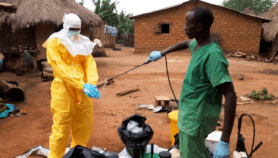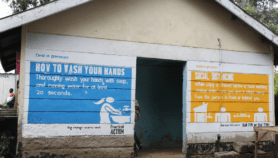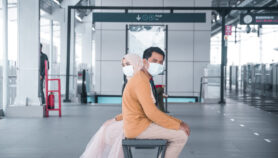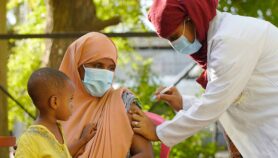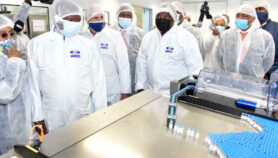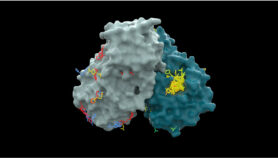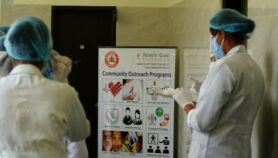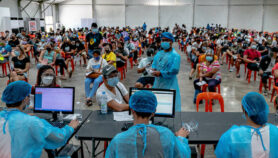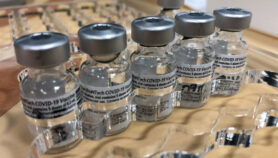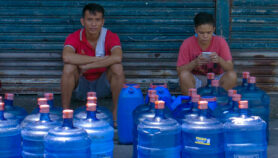By: Hazem Badr
Send to a friend
The details you provide on this page will not be used to send unsolicited email, and will not be sold to a 3rd party. See privacy policy.
COVID-19 poses an unprecedented challenge for many regions, but conflicts and crises in the Middle East add further problems, debilitating already scarce resources and complicating the vaccination process.
The World Health Organization (WHO) is working through its Eastern Mediterranean Regional Office (EMRO) to help 21 countries combat the pandemic. However, Israel’s assault on Gaza, and resulting destruction of infrastructure, has stymied efforts to roll out the vaccine.
SciDev.Net spoke with Ahmed Al-Mandhari, regional director of the WHO, about the situation in the region and access to COVID-19 vaccines, including the WHO-approved Chinese vaccine Sinopharm.
How do you see the impact of the war on Gaza on the WHO’s capacity to provide vaccines to the occupied Palestinian territories?
No doubt recent armed clashes had negative health consequences, particularly with regard to delivering medical supplies and COVID-19 vaccines to the Palestinian territories, especially the besieged Gaza Strip.
WHO had earlier coordinated the delivery of the vaccine to Palestine through COVAX (the facility for equitable vaccine access) and on 29 April, Palestinian territories received a donation of 20,000 doses of the Sputnik V vaccine from Russia.
However, recent clashes hindered the delivery of 10,000 doses of the Sinopharm vaccine, which is still waiting near the checkpoint for permission to enter Gaza. It should have been delivered on 18 May, and hopefully it will enter in the coming days after a ceasefire has been declared.
Do you expect donors to deprioritise vaccination in the region in order to focus on reconstruction efforts?
I think both should go side by side, especially as increased violence in Palestinian territories in the last 10 days resulted in significant damage to several health facilities in Gaza. This made the situation worse for Gaza’s health system, which has already suffered from a lack of medics and basic supplies.
The closure of checkpoints [blocking] patients and medical personnel, and entry restrictions imposed on medical supplies, further aggravates the health crisis in Gaza.
“Medical staff are already working in dire conditions and with limited resources. They shouldn’t also work under the stress of being hit at any moment.”
Ahmed Al-Mandhari, WHO regional director, Eastern Mediterranean Regional Office
Medical teams in the West Bank have been blocked from reaching the sick and injured, and medical staff were themselves hit and injured, while ambulances were damaged or seized and medical facilities broken into.
Medical staff are already working in dire conditions and with limited resources. They shouldn’t also work under the stress of being hit at any moment. Staff and facilities should always be considered a red line.
According to the United Nations High Commissioner for Refugees (UNHCR), conflicts in the region have left around 17 million refugees. How do you plan to vaccinate such a huge number?
Vaccinating refugees is definitely one of the challenges facing countries in the region, as well as the organisation, especially with limited amounts of the vaccine in most of the hosting countries.
Although we have succeeded in delivering vaccines to refugees before, this time we need big amounts, which in turn requires solidarity and coordination with the international community.
What makes it even worse is the instability that poses a real hurdle to delivering vaccines and supplies to hotspots where there are so many displaced personnel.
The World Immunisation and Logistics Summit highlighted the disparities in vaccination between the rich Gulf versus other Arab countries, especially those affected by conflicts like Yemen, Libya and Syria. How does this influence efforts to fight the pandemic?
Disparities in distributing the vaccine is a global issue that really concerns us, as it means lesser priority categories will receive the vaccine at the expense of the highest priority groups.
The discrepancy has reached an unacceptable level, with the rate at 80 per cent in some countries, compared to 1 per cent in others.
One of the reasons is the huge lack in vaccine supplies to COVAX, because of the increased number of cases. By the end of June, we [expect to] have a shortage of 190 million doses from COVAX, while the facility has succeeded in delivering 65 million doses to 124 countries so far. But ultimately it all depends on countries and manufacturers abiding by their commitments.
And while we appreciate the capacity of some companies to increase the speed of delivery, we need other companies to follow suit.
We also need the contribution of high-income countries, offering their surplus vaccines, and we call manufacturing companies to commit to help any country that wants to share their vaccines with COVAX.
In your opinion, how would WHO approval of Sinopharm impact the access to vaccination in the region?
Sinopharm was approved on 7 May, following review by the WHO, and has been added to the list of emergency use [vaccines] once its safety and efficacy has been documented.
WHO has approved it for usage anywhere, which is a prerequisite for potential distribution by COVAX, and has also issued temporary recommendations for the vaccine usage policy.
Sinopharm is also known for being easily stored, which makes it the right fit for low-income countries, and it is the first vaccine to have a smart label to monitor heat damage.
How could the WHO approve the vaccine when clinical trials didn’t target a significant number of people and when, according to a document published by Reuters, some WHO experts were sceptical?
The Strategic Advisory Group of Experts on Immunization (SAGE) had finished its review based on available evidence, and WHO advises adults above 18 years to have its two doses, spaced by three to four weeks. Its efficacy on COVID-19 symptoms reached 79 per cent for all ages grouped together.
A sufficient number of trials have been done on adults in the age group 18-60 years, so there is no need to worry. There have also been some trials on people above 60 years old but on a smaller number, so it is hard to measure the efficacy for this group. Therefore, WHO recommends that countries using the vaccine should monitor its safety and efficacy.
How do you think countries in the region can address the pandemic amid lack of essential scanning resources, capable of recognising new variants?
Yes, new variants have already emerged in the region, and it is a necessity to advance the capacity to perform genome sequencing in all countries, so we are able to identify those variants and monitor any change over time.
In this respect, 13 countries in the region (Bahrain, Egypt, Iran, Jordan, Kuwait, Lebanon, Morocco, Saudi Arabia, Oman, Pakistan, Qatar, Tunisia and United Arab Emirates) have stated they have the capacity to detect any alarming variants. The other eight countries (Afghanistan, Djibouti, Iraq, Libya, Somalia, Sudan, Syria and Yemen) receive WHO support to perform genome sequencing abroad.
Can you tell us more about the situation in the region with regard to new variants, especially the Indian one that is raising concerns?
So far, we have four countries which reported the emergence of the Indian variant – Bahrain, Iran, Jordan and Morocco – among 44 countries worldwide. The British [variant] however, has been reported in Afghanistan, Bahrain, Egypt, Iran, Iraq, Jordan, Kuwait, Lebanon, Libya, Morocco, Pakistan, Qatar, Saudi Arabia, Tunisia and UAE.
Finally, the South African variant has been detected in Bahrain, Iran, Jordan, Libya, Oman, Pakistan, Qatar, Tunisia, UAE, and the Brazilian one emerged only in Jordan and Pakistan.
While countries are struggling to provide the vaccine, several studies conclude that COVID-19 will be seasonal, which requires having multiple doses, as with flu virus. Does the region have the resources for that? And could the WHO support by providing permanent supplies?
We have already considered this as one of the expected scenarios, but this depends to a great extent on vaccinating a significant number of the population, and it is early to tell how the vaccine would be distributed in that case.
The availability of the vaccine poses a bigger challenge than the resources allocated, especially at this stage, where we are not done yet with providing the vaccine to low- and middle-income countries.


![unnamed[2715] unnamed[2715]](https://www.scidev.net/global/wp-content/uploads/unnamed2715-996x567.jpg)



